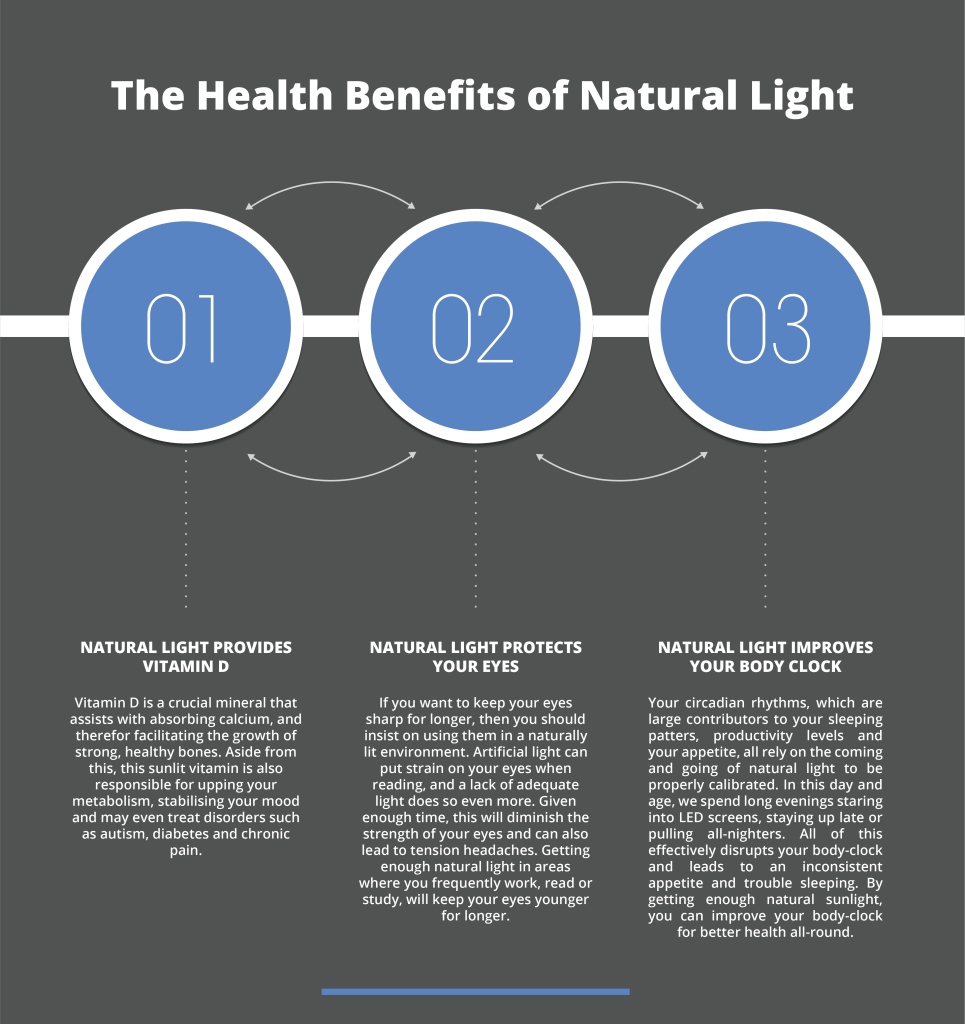
Each day, workers sit at their desks for an average of five hours and 42 minutes. Access to natural light may improve productivity, wellness, and engagement among staff members.
Natural light has been linked to happier employees, lower absenteeism, lower levels of stress, and fewer illnesses. There is also a strong financial case for increasing light in the office since more sunshine may boost worker efficiency and alertness while simultaneously lowering energy expenses.
The advantages of natural light in the workplace surpass any benefits of artificial light. This is supported by a wider trend of the rising relevance of employee welfare.
Advantages of natural light in the workplace
Establish a cheery and welcoming environment
A workplace may seem open and inviting by allowing light to enter through external windows. Glass partition systems may be installed within the room to achieve this. Natural light enhances any architectural style and improves the mood of an environment.
The workforce is healthier
Healthier general health is a logical result of better sleep. Workers exposed to less natural light are more vulnerable to various health problems since such symptoms might contribute to greater weariness.
Natural light at work also boosts happiness since healthier employees are also happier.
Enhanced Staff Productivity
Studies on how lighting impacts productivity in an office have been conducted. It becomes evident that natural light in the workplace boosts productivity among employees. Natural lights generally boost productivity by making workers happier. This boosts output, aids staff retention, and lowers expensive employee turnover.
People are more engaged at work when there is natural lighting. And if they are engaged, they are more likely to maintain their attention on their work. They also have a higher propensity to work well with others in the team. Collaboration and productivity both rise with increasing involvement.
Increase Vitamin D
Vitamin D is sometimes referred to as the ‘Sunshine vitamin.’ It is important for calcium absorption and controls several cellular processes.
The body produces more vitamin D when exposed to the sun regularly, which improves mood, bone health, and general health. As we spend a lot of our time inside, working in inadequate light may negatively affect our general health by causing vitamin D deficits. It’s beneficial to increase vitamin D via workplace illumination.
Promote Greater Sleep
Employees who spend more time in workplaces with natural light than those with low light levels have improved sleep quality. The body’s internal mechanism that regulates our sleep-wake cycle is established and maintained by exposure to natural light.
Employees exposed to natural light sleep longer and more soundly than those who aren’t (at home rather than at their desks). Being exposed to natural light at work may have positive effects that linger long after a person leaves the workplace since they spend a large portion of their day there.
Lessens the need for artificial light
Workplace windows let in natural light and enable daylight harvesting, which uses sunshine to balance power usage and lessen the need for artificial light. Daylight harvesting may save energy consumption and heating costs in offices since lighting can use up to 17% of an office’s energy budget.
In a business structure, artificial lighting typically accounts for one-third of energy use. Depending on various factors, the amount may be a bit higher or lower. The ability of natural light to lessen the need for—and cost of—artificial lighting is nothing new.
To save electricity expenses, the correct sort of design, layout, and window goods are crucial. This is done to avoid having lighting savings cancelled out by heat loss via windows or too much sun exposure during the summer.
Fosters a Connection to Nature
Our environment has changed to one where people spend much of their time inside. Climate-controlled buildings, many of which lack natural light, have a detrimental impact on mental health generally and a rise in seasonal depression rates.
Allowing natural light into the workplace fosters a connection to the outside, which has a number of advantages, including higher productivity and better job performance.
Boosts Energy Levels
It has been shown that some workers experience fatigue or extreme fatigue in the workplace when there isn’t enough natural light.
On the other hand, it has been shown that having natural light in the workplace boosts energy levels. More energised employees will undoubtedly be more creative and productive.
Value of the place is increased by natural light
Prospective renters are more likely to be drawn to office space with plenty of natural daylight. Natural light makes a room seem larger and more welcoming, which encourages a potential renter to pay more.
Space with little natural light costs less to lease and stays on the market longer than similarly sunny spaces.

Health benefits of natural light (Source)
Office Lighting Design Techniques
You need to have a clear vision and reliable advice in order to fully benefit from and harness the therapeutic potential of natural light in workplace environments. Here are a few unique daylighting design techniques used by architects to maximise the amount of light that enters areas in order to increase worker happiness while also taking into account various lighting challenges:
Give spaces that are often visited with natural lighting
Too strong or dim lighting strains the eyes and causes headaches. Most workstations having access to natural light is one approach to address this issue since natural light is strong but not as harsh as artificial light.
Installing skylights is a great choice if you have an open floor plan workplace with many workstations or cubicles in the middle of the space, away from any side windows.
Use a matte finish
Dark hues absorb light, whereas light colours reflect it more efficiently. However, glare may be caused by the sheen of the paint. A matte finish will reduce glare.
Use landscape to your advantage
Plant trees and bushes that will shade ground-level office areas from the sun’s glare. Additionally, attractive landscaping encourages your employees to take breaks outside.
Install lighting that looks like natural light
Consider using desktop work lamps that produce light in the same spectrum as natural daylight in offices where artificial light must be used to augment natural light. Additionally, you may add light dimmers that change automatically depending on the quantity of ambient light.
Conclusion
Workers who work under natural light are more inclined to work a full schedule and are also happy while doing so. Natural light and vitamin D have a well-researched relationship. Therefore, natural light in the workplace is a necessity.
